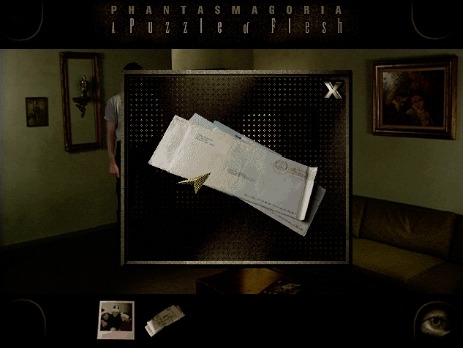

The final gameplay segment is the type where you need to click on very specific items in a short period of time or else you’ll be killed. Up until the late stages of the game, there’s no way to die, either. The game also realizes that maybe players could get stuck – in which case you can immediately start at any of the seven chapters, although you usually miss some introductory videos. Your directions are rarely clarified in the narrative, requiring you to hit the red skull button on the bottom of the screen, which gives you not-so-subtle clues to your current goal.

These are never actually difficult, but most of the trouble lies in figuring out exactly where the items are. Phantasmagoria has puzzles in a vague sense, inasmuch as there’s an inventory, and occasionally you’ll need to use items in other places to move on. To be fair, in Myst there were at least some puzzles so it justified itself as more than just a slideshow. It was also released during a time when clicking around and looking at the pretty pictures was considered an acceptable game mechanic. Phantasmagoria arrived a few years after Myst, and its design seems to be trying to capitalize on the casual audience that made Cyan’s game such an enormous success. As such, it feels more like you’re just clicking hotspots until the next video sequence plays. It feels like time ill spent – there is literally one whole chapter (and one whole CD) solely devoted to Adrienne visiting town and buying drain cleaner.

A good chunk of it involves Adrienne wandering around the mansion, unlocking previously locked doors and conversing with the sparse townsfolk. The plot is so easily telegraphed that you can figure it all out within the first five minutes of play, but there are seven whole CDs to be filled. It should also be no shock that the same demon that inhabited Zoltan has inhabited Don, whom Adrienne must outwit in the climactic chase sequence of the final chapter.Īs any horror fan can tell you, suspense is all in the buildup. (The “Phantasmagoria” is the name of an escape trick wherein he’s tied to a chair and must escape before his head is sliced by a swinging blade.) Each of his ladies died under tragic circumstances – it should be no shock that he was possessed by a demon and murdered them. As Adrienne eventually discovers, the mansion was previously owned by a magician named Zoltan Carnovasch, who had more wives than Henry VIII. Furthermore, Adrienne’s sleep is disturbed by gruesome nightmares. As Adrienne begins to explore around the mansion and discover all of its secrets, Don gets possessed by an evil spirit and begins acting psychotically abusive.
#Phantasmagoria game nude full#
It is, of course, haunted – as if the room full of weaponry and the functioning electric chair weren’t some kind of tipoff. Donald Gordon and Adrienne Delaney, a young married couple from Boston, find an astonishing deal on a gorgeous mansion out in the boonies. The story of Phantasmagoria is cribbed almost directly from Stephen King’s The Shining. It’s an admirable attempt, but like practically every FMV-based game, it falls victim to two things: terrible production values and incredibly sparse gameplay. If King’s Quest IV dared to make gamers cry, Phantasmagoria dared to give gamers nightmares. Phantasmagoria was to be something different, a truly adult horror story. It didn’t help that, by most accounts, the game was pretty bad.īy the mid ‘80s, Roberta Williams was still mostly known for her fairy tale style King’s Quest, with a few dalliances in murder mysteries with the Laura Bow games. History eventually confirmed that FMV-based games were an evolutionary dead end, however, marking Phantasmagoria as a call-to-arms for a war that never happened. It’s certainly revolutionary in combining full motion video of live actors with the framework of an adventure game. Still, while Mystery House and King’s Quest remain important landmarks – the former for introducing graphics to text adventures, the latter for implementing full visuals and character controls – Phantasmagoria doesn’t command nearly the same respect.

Would it be too harsh to criticize Roberta Williams? She was undoubtedly a pioneer of the adventure gaming scene, but years and years of genre evolution have revealed that maybe she wasn’t the best game designer.


 0 kommentar(er)
0 kommentar(er)
